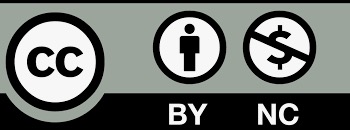Published
2024-01-05
Issue
Section
Research Articles
License
The journal adopts the Attribution-NonCommercial 4.0 International (CC BY-NC 4.0), which means that anyone can reuse and redistribute the materials for non-commercial purposes as long as you follow the license terms and the original source is properly cited.
Author(s) shall retain the copyright of their work and grant the Journal/Publisher rights for the first publication with the work concurrently licensed since 2023 Vol.8 No.2.
Under this license, author(s) will allow third parties to download, reuse, reprint, modify, distribute and/or copy the content under the condition that the authors are given credit. No permission is required from the authors or the publisher.
This broad license intends to facilitate free access, as well as the unrestricted use of original works of all types. This ensures that the published work is freely and openly available in perpetuity.
By providing open access, the following benefits are brought about:
- Higher Visibility, Availability and Citations-free and unlimited accessibility of the publication over the internet without any restrictions increases citation of the article.
- Ease of search-publications are easily searchable in search engines and indexing databases.
- Rapid Publication – accepted papers are immediately published online.
- Available for free download immediately after publication at https://esp.as-pub.com/index.php/ESP

Copyright Statement
1.The authors certify that the submitted manuscripts are original works, do not infringe the rights of others, are free from academic misconduct and confidentiality issues, and that there are no disputes over the authorship scheme of the collaborative articles. In case of infringement, academic misconduct and confidentiality issues, as well as disputes over the authorship scheme, all responsibilities will be borne by the authors.
2. The author agrees to grant the Editorial Office of Environment and Social Psychology a licence to use the reproduction right, distribution right, information network dissemination right, performance right, translation right, and compilation right of the submitted manuscript, including the work as a whole, as well as the diagrams, tables, abstracts, and any other parts that can be extracted from the work and used in accordance with the characteristics of the journal. The Editorial Board of Environment and Social Psychology has the right to use and sub-licence the above mentioned works for wide dissemination in print, electronic and online versions, and, in accordance with the characteristics of the periodical, for the period of legal protection of the property right of the copyright in the work, and for the territorial scope of the work throughout the world.
3. The authors are entitled to the copyright of their works under the relevant laws of Singapore, provided that they do not exercise their rights in a manner prejudicial to the interests of the Journal.
About Licence
Environment and Social Psychology is an open access journal and all published work is available under the Creative Commons Licence, Authors shall retain copyright of their work and grant the journal/publisher the right of first publication, and their work shall be licensed under the Attribution-NonCommercial 4.0 International (CC BY-NC 4.0).
Under this licence, the author grants permission to third parties to download, reuse, reprint, modify, distribute and/or copy the content with attribution to the author. No permission from the author or publisher is required.
This broad licence is intended to facilitate free access to and unrestricted use of original works of all kinds. This ensures that published works remain free and accessible in perpetuity. Submitted manuscripts, once accepted, are immediately available to the public and permanently accessible free of charge on the journal’s official website (https://esp.as-pub.com/index.php/ESP). Allowing users to read, download, copy, print, search for or link to the full text of the article, or use it for other legal purposes. However, the use of the work must retain the author's signature, be limited to non-commercial purposes, and not be interpretative.
Click to download <Agreement on the Licence for the Use of Copyright on Environmental and Social Psychology>.
How to Cite
Accounting students’ perspective of learning law course
Hanna Ambaras Khan
School of Business and Economics, University Putra Malaysia
DOI: https://doi.org/10.54517/esp.v9i3.2083
Keywords: accounting students, company law, pedagogy, non-law students, teaching method
Abstract
Law subject is not exclusive to law students only. There are many faculties that offer law subjects to the students. In terms of teaching and learning law, there are a few methods such as lectures, drafting, and case study. However, teaching law to non-law students needs creativity. The non-law student’s perception of law subject is important to develop interest in the learning process. Most non-law students thought law was difficult and uninteresting. Hence, there is a need to revise the method of teaching and learning to attract students’ attention and interest and to change their perception of learning law subjects. The objective of this research is to study the change in the accounting students as non-law students’ perspective in learning law using a mix of conventional and revised methods, and whether there is any change in their perception. This paper adopts a qualitative research method to collect data. The findings of the research show that a mix of conventional traditional, and revised methods changed students’ perspectives about learning law subjects. The mixed method is seen as fun and suitable for accounting students to learn law. It is suggested to have many other activities created as assessment methods in teaching law to accounting students.
References
[1]. Razak FA, Osoman A, Patel IFM. Teaching Law to Non-Law Background Students: Challenges and Strategies. International Journal of Humanities and Social Science Invention. 2020, 9(3): 51-55.
[2]. Zeigler DH. How I Teach. Tribeca Square Press; 2008.
[3]. Acharjee M. Teaching Methods in Law. Journal of Legal Studies and Criminal Justice. 2020, 1(1).
[4]. Upadhyay NK. New methods of teaching law problems & perspectives. Proceedings of International Young Scholars Workshop. 2020, 9. doi: 10.47344/iysw.v9i0.193
[5]. Morris RJ. The teaching of law to non‐lawyers. International Journal of Law in the Built Environment. 2010, 2(3): 232-245. doi: 10.1108/17561451011087328
[6]. Cameron C. Corporate villains: taking the bore out of law. Accounting Research Journal. 2012, 25(1): 56-66. doi: 10.1108/10309611211244537.
[7]. Raushan P. Legal Education and the Present Pedagogical Techniques. JusCorpus Law Journal. 2021.
[8]. Khan HA. Business Students’ Perspective of Learning Law Education. Studies of Applied Economics. 2021, 39(10). doi: 10.25115/eea.v39i10.5407
[9]. Allen V. A Critical Reflection on the Methodology of Teaching Law to Non-law Students. Kingston University Research Repository; 2007.
[10]. De Silva C, Cowap C. The Teaching of Law to Non-Lawyers. Available online: https://www.irbnet.de/daten/iconda/CIB11437.pdf (accessed on 22 December 2022).
[11]. Kariyawasam K, Low HY. Teaching Business Law to Non-Law Students, Culturally and Linguistically Diverse (‘CaLD’) Students, and Large Classes. Journal of University Teaching and Learning Practice. 2014, 11(2): 121-141. doi: 10.53761/1.11.2.9
[12]. Braun V, Clarke V. Successful Qualitative Research: A Practical Guide for Beginners. SAGE; 2013.
[13]. Surveyplanet. When are Surveys Qualitative or Quantitative Research—Learn the difference! Available online: https://blog.surveyplanet.com/what-is-a-survey-and-what-types-of-surveys-are-qualitative-vs-quantitative (accessed on 22 December 2022).
[14]. Braun V, Clarke V, Boulton E, et al. The online survey as a qualitative research tool. International Journal of Social Research Methodology. 2020, 24(6): 641-654. doi: 10.1080/13645579.2020.1805550







